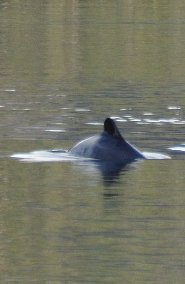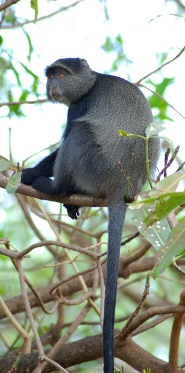Friday 30 October 2009
Black Dolphins - one of the smallest species of all of the cetaceans
 Black dolphins
Black dolphins (
Cephalorhynchus eutropia) are known by many other names such as Chilean dolphins, Chilean black dolphins, and white-bellied dolphins. These small cetaceans have blunt, beakless heads and a stock body shape. The average length of this dolphin is 67 inches (1.7 m) and a mature dolphin weighs around 132.27 lbs (60 kg). Their flippers and the large dorsal fin are round in shape. The color of the coat is gray but the ventral sides are light in color. There are white markings on their forehead, throat, lips, and in the area behind their flippers. There is a dark gray band round their throat. There are vertical lines known as fetal folds on a baby black dolphin. It is believed that before birth, the calf is tightly curved in its mother's womb.
Black dolphins are mainly found in cold water. Their habitats are in the shallow coastal waters of Chile, South America, Argentina, Cape Horn, Beagle Channel, and to the south of Isla Navarino. This species is thought to be highly gregarious since they roam about in small groups of 2 to 10 individuals. In the northern range, there are 20 to 50 individuals in a group. Valdivia near Chiloe and the gulf of Arauco are places where these dolphins are found in abundance.
Black dolphins like feeding on crustaceans, fish, and cephalopods. They also eat fish as anchovies, sardines, schooling fish, and squids. Their diet sometimes also includes green algae. There is no information about the reproduction pattern of Black dolphins yet.
Just like other species of dolphins, the black dolphins can also swim very fast. They can cover short distances rapidly with a speed of 20 mph. Then they sense any kind of danger, they swim even faster but at the same time, they get tired soon. At a normal speed, they can swim for hours and can cover long distances with a speed of 4 to 6 mph. Some population of the Black dolphins may migrate seasonally but others remain in one area through out the year.
In southern Chile, dolphins which accidentally get trapped in nets are used as bait to lure crabs or for human consumption. The complex channels and islands make it impossible to protect this species against hunting. The increasing aquaculture industry may have also invaded the habitats of black dolphins.
Picture of the black dolphin by Frank Holden, licensed under
Creative Commons Attribution ShareAlike 3.0
You can help spreading the word about this animal by liking it on facebook
Permanent Link
Sunday 25 October 2009
Blue Monkey - A Social Native of Africa

The
Blue Monkey (
Cercopithecus mitis) also known as the Diademed Monkey is a member of the guenon genus. It is native to East and Central Africa, Ranging from the northern part of the Congo River Basin to the east of the Great Rift Valley and to the south of northern Zambia and Angola.
Although, called 'Blue Monkey', the 'blue' is not really noticeable. The small hair on its face sometimes gives the impression of blue color and hence its name. Apart from its face, its coat is grey or olive in color and there is a yellowish patch on its forehead called the 'Diadem' from which the name Diademed Monkey has been derived. Its legs, feet, and cap are black and the mantle is brown, grey, or olive depending on the species. The Blue Monkey has pouch in its cheeks to carry food while foraging. An average mature blue monkey is 19.68 - 25.59 inches (50 - 65 cm) long and the length of its tail is equal to the length of the rest of its body. The female blue monkey weighs about 8.81 lbs (over 4 kg) and the weight of the male is about 17.63 lbs (8 kg).
The Blue Monkey is mainly found in bamboo forests, evergreen forests, and in thick forest canopies. It very rarely comes to the ground. In order to meet its need of water, it depends on the humid and shady areas where water is found in plenty. Leaves and fruits are its main food but it sometimes eats slow moving invertebrates as well. Tall trees are its most preferred home where it gets both the required shelter and food. Since the green cover is vanishing rapidly, it is also suffering the loss of its natural habitat like other animals. At places where the pine trees are replacing the natural green cover, the blue monkey is considered a threat as it may strip the bark in search of food and moisture. Humans also hunt it for its bushmeat.
The Blue Monkey males are larger than the females. Females generally give birth once in two years during the start of warm, moist rainy seasons. The gestation period lasts for about 5 months. Infants take birth with their eyes open and fur all over their body. The Blue Monkey roosts in groups of 10-40 individuals with only one adult male.
This species believes in the unmale-per-group tendency and the male receives the copulations from the females in the group. The male guards the group from any predators and females also join him in this activity. The stronger male sometimes ousts the male thereby overtaking the troop. In order to protect themselves from predators, these Blue Monkeys get mixed with other species of monkeys. No competition is seen between the two groups since they forage in diverse locations.
This species has a variety of habitats but it always stays close to water. Somalia, Angola, South Africa, Zambia, Zimbabwe, Uganda, Tanzania, Sudan, Malawi, Kenya Burundi, Ethiopia, Zaire, Rwanda, and Mozambique are countries where the Blue Monkey is found in abundance.
Picture of the blue monkey by Pedro Gonnet, licensed under
Creative Commons Attribution 2.5 License.
You can help spreading the word about this animal by liking it on facebook
Permanent Link
Sunday 11 October 2009
Muskrats - Water-loving Rats

The
Muskrat (
Ondatra zibethicus), is a semi-aquatic, medium-sized rodent. It is found in North America and has also been recently introduced in Asia, South America, and Europe. The main habitat of muskrat is wetlands but this animal can successfully adapt to different habitats and climates. It is very beneficial to nature and important to humans for its fur and as food.
Muskrats are not the true rats which belong to the genus
Rattus. There are two scent glands near its tail which give off a strong musky smell that is used by muskrat to declare its territory. It is this attribute of the muskrat that has given it its name.
The size of an average muskrat is around 16 - 24 inches (40 - 60 cm). The size of its tail is almost double its body size and it weighs about 1.5 - 4 lb (0.7 - 1.8 kg). An adult muskrat is just a little longer than the brown rat but it weighs four times the weight of brown rat. It has a medium or dark brown coat with small but thick hair and the color of its belly is lighter than the body. The two-layer fur protects it from cold water. Instead of hair, they have scales on their long tail which flattens vertically to help them in swimming.
Muskrats spend a lot of time in water. They can stay under water for more than 15 minutes. They have the ability to close their ears when under water. Their semi-webbed hind feet help them a great deal in swimming but their tail plays a main role as a means of propulsion.
They are found in marshy lands close to salt water or fresh water wetlands, ponds, rivers, or lakes. Since the construction of canals and other irrigation channels is being created on large scales, muskrats are especially becoming common in these areas. Muskrats can survive in areas where sulfurous water from coal mines is released. Muskrats may occupy that area of water where other animals such as frogs or fish perish.
Like other rodents, muskrats are also prolific breeders. Females can give birth to 2-3 litters per year and there can be 6-8 young ones in each litter. The babies are very small and weigh only 0.8 oz (22 gm) at birth. In warm environment, it matures just in six months while in a cold climate it may take one year to mature.
Muskrats are active when it is cool at night, dawn, or dusk. Aquatic vegetation or cattails are their main food. Although plant materials fulfill 95% of their food needs, sometimes, they may also eat small animals such as frogs, fish, and mussels etc.
You can help spreading the word about this animal by liking it on facebook
Permanent Link
 Black dolphins (Cephalorhynchus eutropia) are known by many other names such as Chilean dolphins, Chilean black dolphins, and white-bellied dolphins. These small cetaceans have blunt, beakless heads and a stock body shape. The average length of this dolphin is 67 inches (1.7 m) and a mature dolphin weighs around 132.27 lbs (60 kg). Their flippers and the large dorsal fin are round in shape. The color of the coat is gray but the ventral sides are light in color. There are white markings on their forehead, throat, lips, and in the area behind their flippers. There is a dark gray band round their throat. There are vertical lines known as fetal folds on a baby black dolphin. It is believed that before birth, the calf is tightly curved in its mother's womb.
Black dolphins (Cephalorhynchus eutropia) are known by many other names such as Chilean dolphins, Chilean black dolphins, and white-bellied dolphins. These small cetaceans have blunt, beakless heads and a stock body shape. The average length of this dolphin is 67 inches (1.7 m) and a mature dolphin weighs around 132.27 lbs (60 kg). Their flippers and the large dorsal fin are round in shape. The color of the coat is gray but the ventral sides are light in color. There are white markings on their forehead, throat, lips, and in the area behind their flippers. There is a dark gray band round their throat. There are vertical lines known as fetal folds on a baby black dolphin. It is believed that before birth, the calf is tightly curved in its mother's womb. 
 The
The  The
The